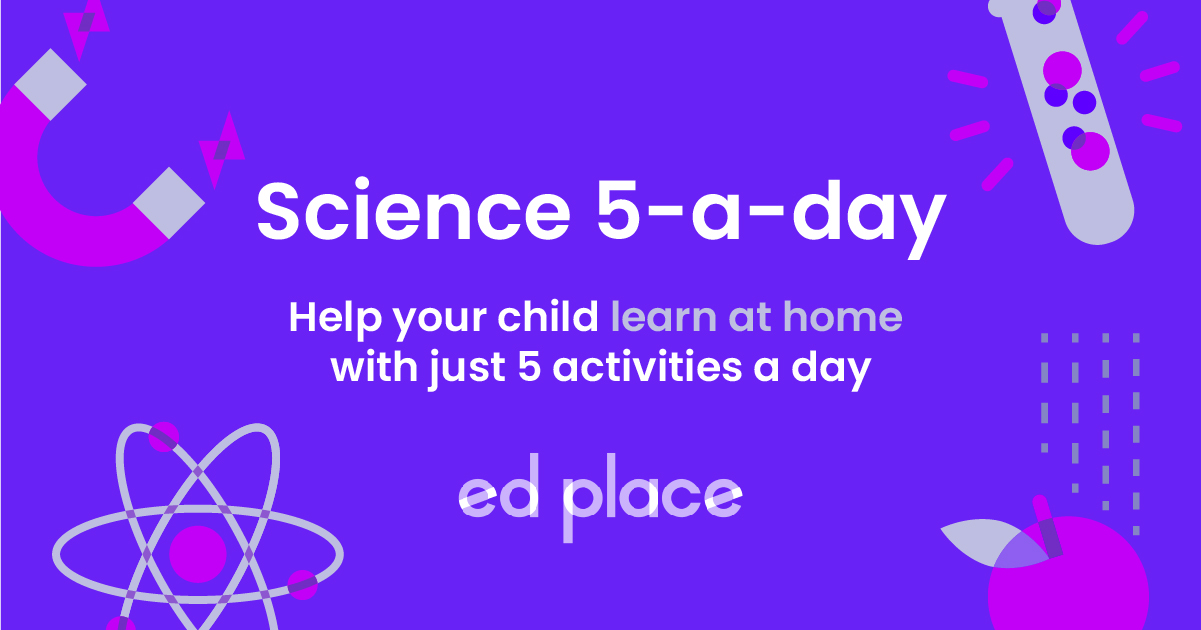
EdPlace's Lower Key Stage 2 Home Learning Science Lesson: Flowers
Looking for short lessons to keep your child engaged and learning? Our experienced team of teachers have created English, maths and science lessons for the home, so your child can learn no matter where they are. And, as all activities are self-marked, you really can encourage your child to be an independent learner.
Get them started on the lesson below and then jump into our teacher-created activities to practice what they've learnt. We've recommended five to ensure they feel secure in their knowledge - 5-a-day helps keeps the learning loss at bay (or so we think!).
Are they keen to start practising straight away? Head to the bottom of the page to find the activities.
Now...onto the lesson!
Flowering plants: What are flowers for and how do they work?
Every good lesson has a purpose or an objective.
We're confident that if you follow the step-by-step approach below your child will be able to:
1) Understand why plants produce flowers and what they’re for.
2) Apply this understanding to be able to...
3) Explain their understanding back to you, if they've really grasped it!
Step 1: Key Terminology
Well, we’ve got three things here: why do plants go to the bother of making flowers at all, how they’re put together and how they work.
First of all, it’s important to understand that plants, like anything, else, need to reproduce themselves. That’s what flowers are for – making more plants! Weirdly, both the male parts and the female parts are there – in the same flower!
Next, it’s the design or construction of flowers we need to break down – how they’re put together. Only then will the way they operate make a bit more sense. This is definitely one area in which children struggle – there are so many tricky names for the flower ‘bits’ that need to be sorted out and understood. So let’s tackle that first.
We’re going to concentrate on flowers that are visited by insects, as they’re much more obvious than the wind-pollinated ones, and often their ‘bits’ or structures are easier to see. This is definitely one of those topics you need to get out there and practise in the real world, so make use of all those summer blooms to get down to earth, get your nose in the flower, and check out what’s going on.
So, what ‘bits’, or structures, are important to get sorted out? It’s all a bit flowery!
Petals – are the large colourful structures that advertise the flower to the insects.
Stamens – the male part of the flower (remember: sta-MEN) that makes the pollen grains.
Made up of: Anther (pollen factory) and Filament (stalk holding the anther up).
Carpel – the female part of the flower, where the eggs are made.
Made up of: Stigma (where the pollen lands – stig-MA helps to remember it’s female!
Style (stalk holding up the stigma) and Ovary (where the eggs are made).
Ovules (that’s the eggs inside the ovary).
Sepal – the little ‘leaves’ that protect the petals inside the flower bud.
Stalk – holds the flower up.
Phewee! That’s an awful lot of awkward words – they truly need sorting out and making sense of and that happens when we see how flowers work – then all those names fall into place.
Step 2: Stamens vs Stigma
So, what have we got: plants reproduce by using flowers, which are designed with male and female parts inside, and arranged so that the male parts, which make pollen, can get that pollen transferred to the female parts of the same sort of flower on a different plant.
The staMENs are male and make pollen to be taken to the female stigMA on a different flower.
How does this happen? Flowers recruit insects like bees to do this job for them – like a postman!
How can we make sense of all this? Let’s see….
Step 3: The Pollen Process
First off, if you’ve got a package you need sent somewhere else, how do you do that? You give it to someone to deliver! Well, to make more plants, flowers have to send their pollen to a different flower. The pollen is male and needs to be delivered to the female parts to make new plants.
Make sense?
But how? Ever seen bees and other insects visiting flowers? Of course you have! Well, flowers have very cleverly recruited them to be their postmen – delivering pollen grains. But how? Don’t the posties want paying? Well, they are – in the form of a sweet liquid they love, called NECTAR. This is made deep in the flower and flowers advertise the ‘nectar-sale’ by having colourful petals and a lovely scent that say, “Nectar on offer here – come and get it!” The bees do just that – and they collect the pollen while they’re in the flower, drinking the nectar. Clever stuff, huh?
Now, let’s have a look at how a flower is designed:

Where’s the nectar?
At the bottom of the flower.
So the bees and other insects have to get past the stamens to get to it.
What do the staMENs make?
Male pollen grains.
So, what do the bees get covered in as they reach into the flower to get nectar?
Pollen! Loads and loads of yellow powdery pollen.
Where will the insect go next?
To another flower – it wants more nectar!
What’s the female part that’s poking up, just in the way, as the bee reaches down for the nectar?
The stigMA.
The top of the stigma is very sticky and that’s where some of the pollen grains get rubbed off.
Job done!
The next bit happens deep inside the carpel, out of sight, but the pollen grain joins with one of the eggs (or ovules) and that makes a seed – the next generation of plants!
Step 4: The Delivery Bee
OK, now it’s time to imagine you’re a bee and you’re on this journey, so try to answer these questions from the perspective of being a bee (or butterfly, or another insect that visits flowers).
1. You’re hungry – what do you want to eat/drink?
2. There’s some in that flower! How is the flower telling you it’s there? (two things)
3. You reach the flower and land on it. You reach into the flower to get the food. What’s all this yellow powdery stuff you’re getting covered
4. Yum, that was lovely! You want more – where can you find some more?
5. So, you visit another flower, and when you reach in, there’s a pokey bit sticking up in the middle of the flower that you have to get past to get the sticky stuff. What gets rubbed off here?
Right, so that was the bee’s journey – now let’s look at it in more detail – can you remember what’s actually happening?
6. Remember, what is the purpose of a plant making flowers at all?
7. So, that means that male and female parts have to be joined together. What is the name of the male part that makes the pollen grains?
8. The female part has a sticky top, designed for the pollen grains to stick to it – what’s it called?
9. The pollen grains meet with the eggs, deep in the female part. What are the eggs called?
10. Once they’ve joined, a tiny capsule contains the next generation of plants – what is it?
Did you enjoy the bee’s journey? If you can really picture these (and it massively helps if you can get out there and look at the actual flowers and imagine you’re a bee) then the questions become a whole lot easier to answer!
Step 5 - Let's put your grouping knowledge to the test while it's still fresh in your mind...
Now, you’ve had some practice, why not assign your child the following five activities in this order to test their understanding.
All activities are created by teachers and automatically marked. Plus, with an EdPlace subscription, we can automatically progress your child at a level tailored to their needs. Sending you progress reports along the way so you can track and measure progress, together - brilliant!
Activity 1 - What do plants need? 1
Activity 2 - What do plants need? 2
Activity 5 - Pollination and Fertilisation
Answers
1. Nectar – it’s sweet and sticky and you love it!
2. Colourful petals and lovely scent – flowers are brilliant at advertising!
3. Pollen grains – millions of them.
4. In another flower – so off you go!
5. Pollen gets rubbed off on the stigma – it’s sticky.
6. Reproducing – making more plants.
7. The stamen makes the pollen in its pollen factories (called anthers).
8. The female part is called the carpel and the sticky pollen-receiver at the top is the stigma.
9. A plant’s eggs are called ovules and they’re made in the ovary of the flower.
10. Seeds are like tiny space capsules, containing the next generation of that plant, destined to be spread around the universe of your garden … or beyond!
Keep going! Looking for more activities, different subjects or year groups?
Click the button below to view the EdPlace English, maths, science and 11+ activity library








